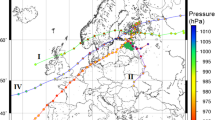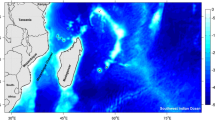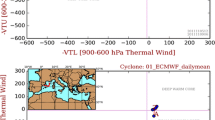Abstract
Weather Research and Forecasting atmosphere model and Finite Volume Community Ocean Model were for the first time used under the pseudo-climate simulation approach, to study the parameters of an extreme storm in the Baltic Sea area. We reconstructed the met-ocean conditions during the historical storm Gudrun (which caused a record-high +275 cm surge in Pärnu Bay on 9 January 2005) and simulated the future equivalent of Gudrun by modifying the background conditions using monthly mean value differences in sea surface temperature (SST), atmospheric air temperature and relative humidity from MIROC5 in accordance with the IPCC scenarios RCP4.5 and RCP8.5 for 2050 and 2100. The simulated storm route and storm surge parameters were in good accordance with the observed ones. Despite expecting the continuation of recently observed intensification of cyclonic activity in winter months, our numerical simulations showed that intensity of the strongest storms and storm surges in the Baltic Sea might not increase by the end of twenty-first century. Unlike tropical cyclones, which derive their energy from the increasing SST, the extratropical cyclones (ETCs) harvest their primary energy from the thermal differences on the sides of the polar front, which may decrease if the Arctic warms up. For climatological generalizations on future ETCs, however, it is necessary to re-calculate a larger number of storms, including those with different tracks and in different thermal conditions.













Similar content being viewed by others
References
Cormier R et al (2013) Marine and coastal ecosystem-based risk management handbook. ICES Cooperative Research Report No. 317. p 60
Averkiev AS, Klevannyy KA (2010) A case study of the impact of cyclonic trajectories on sea-level extremes in the Gulf of Finland. Cont Shelf Res 30:707–714
BACC (2015) In: The BACC II Author Team (ed) Second assessment of climate change for the Baltic Sea Basin. Reg Clim St. Springer, p 501
Bader J, Mesquita MDS, Hodges KI, Keenlyside N, Østerhus S, Miles M (2011) A review on Northern Hemisphere sea-ice, storminess and the North Atlantic Oscillation: observations and projected changes. Atmos Res 101:809–834
Beljaars ACM (1994) The parameterization of surface fluxes in large-scale models under free 530 convection. Q J R Meteorol Soc 121:255–270
Bogdanov VI, Medvedev MY, Solodov VA, Trapeznikov YA, Troshkov GA, Trubitsina AA (2000) Mean monthly series of sea level observations (1777–1993) at the Kronstadt gauge. Reports of the Finnish Geodetic Institute 2000:1, Kirkkonummi, Finland
Booth JF, Wang S, Polvani L (2013) Midlatitude storms in a moister world: lessons from idealized baroclinic life cycle experiments. Clim Dyn 41:787–802
Carpenter G (2005) Windstorm Erwin/Gudrun—January 2005. Specialty Practice Briefing 2
Chen C, Liu H, Beardsley RC (2003) An unstructured grid, finite-volume, three-dimensional, primitive equations ocean model: application to coastal ocean and estuaries. J Atmos Oceanic Tech 20:159–186
Christensen OB, Kjellström E, Zorita E (2015) Projected change—atmosphere. In: The BACC II Author Team (ed) Second assessment of climate change for the Baltic Sea Basin. Springer, Cham, pp 217–233
Dyer AJ, Hicks BB (1970) Flux–gradient relationships in the constant flux layer. Q J R Meteorol Soc 96:715–721
Emanuel K (2005) Increasing destructiveness of tropical cyclones over the past 30 years. Nature 436:686–688
Feser F, Barcikowska M, Krueger O, Schenk F, Weisse R, Xia L (2015) Storminess over the North Atlantic and northwestern Europe—a review. Q J R Meteorol Soc 141:350–382
Gregow H, Ruosteenoja K, Pimenoff N, Jylhä K (2012) Changes in the mean and extreme geostrophic wind speeds in Northern Europe until 2100 based on nine global climate models. Int J Climatol 32:1834–1846
Groenemeijer P, Vajda A, Lehtonen I, Kämäräinen M, Venäläinen A, Gregow H, Becker N, Nissen K, Ulbrich U, Paprotny D, Morales Nápoles O, Púčik T (2016) Present and future probability of meteorological and hydrological hazards in Europe. D2.5 report, RAIN project. http://rain-project.eu/wp-content/uploads/2016/09/D2.5_REPORT_final.pdf
Hansen J, Sato M, Hearty P, Ruedy R, Kelley M, Masson-Delmotte V, Russell G, Tselioudis G, Cao J, Rignot E, Velicogna I, Tormey B, Donovan B, Kandiano E, von Schuckmann K, Kharecha P, Legrande AN, Bauer M, Lo KW (2016) Ice melt, sea level rise and superstorms: evidence from paleoclimate data, climate modeling, and modern observations that 2 °C global warming could be dangerous. Atmos Chem Phys 16:3761–3812
Harvey BJ, Shaffrey LC, Woollings TJ (2014) Equator-to-pole temperature differences and the extra-tropical storm track responses of the CMIP5 climate models. Clim Dyn 43:1171–1182
Hill D (2012) The lessons of Katrina, learned and unlearned. J Coastal Res 29:324–331
Honda C, Mitsuyasu K (1980) Laboratory study on wind effect to ocean surface. J Coast Eng JSCE 27:90–93 (in Japanese)
Hong SY, Lim JOJ (2006) The WRF single–moment 6–class microphysics scheme (WSM6). J Korean Meteorol Soc 42:129–151
Hong SY, Noh Y, Dudhia J (2006) A new vertical diffusion package with an explicit treatment of entrainment processes. Mon Weather Rev 134:2318–2341
Jaagus J, Suursaar Ü (2013) Long-term storminess and sea level variations on the Estonian coast of the Baltic Sea in relation to large-scale atmospheric circulation. Est J Earth Sci 62:73–92
Jacob D, Elizalde A, Haensler A, Hagemann S, Kumar P, Podzun R, Rechid D, Remedio AR, Saeed F, Sieck K, Teichmann C, Wilhelm C (2012) Assessing the transferability of the regional climate model REMO to different coordinated regional climate downscaling experiment (CORDEX) regions. Atmosphere 3:181–199
Johansson MM, Kahma KK (2016) On the statistical relationship between the geostrophic wind and sea level variations in the Baltic Sea. Boreal Environ Res 21:25–43
Kall T, Liibusk A, Wan J, Raamat R (2016) Vertical crustal movements in Estonia determined from precise levellings and observations of the level of Lake Peipsi. Est J Earth Sci 65:27–47
Kawase H, Yoshikane T, Hara M, Kimura F, Yasunari T, Ailikun B, Ueda H, Inoue T (2009) Intermodel variability of future changes in the Baiu rainband estimated by the pseudo global warming downscaling method. J Geophys Res 114:D24110
Kimura F, Kitoh A (2007) Downscaling by pseudo global warming method. The Final Report of ICCAP, pp 43–46
Knutson TR, Tuleya RE (2004) Impact of CO2-induced warming on simulated hurricane intensity and precipitation: sensitivity to the choice of climate model and convective parameterization. J Clim 17:3477–3495
Kont A, Endjärv E, Jaagus J, Lode E, Orviku K, Ratas U, Rivis R, Suursaar Ü, Tõnisson H (2007) Impact of climate change on Estonian coastal and inland wetlands—a summary with new results. Boreal Environ Res 12:653–671
Lambert SJ, Fyfe JC (2006) Changes in winter cyclone frequencies and strengths simulated in enhanced greenhouse warming experiments: results from the models participating in the IPCC diagnostic exercise. Clim Dyn 26:713–728
LeBlond PH, Mysak LA (1978) Waves in the ocean. Elsevier oceanographic series, vol 20. Elsevier, Amsterdam, p 602
Magaard L, Krauss W (1966) Spektren der Wasserstandsschwankungen der Ostsee im Jahre 1958. Kieler Meeresforsch 22:155–162
Matulla C, Schöner W, Alexandersson H, von Storch H, Wang XL (2008) European storminess: late nineteenth century to present. Clim Dyn 31:125–130
Mizuta R (2012) Intensification of extratropical cyclones associated with the polar jet change in the CMIP5 global warming projections. Geophys Res Lett 39:L19707
Mizuta R, Matsueda M, Endo H, Yukimoto S (2011) Future change in extratropical cyclones associated with change in the upper troposphere. J Clim 24:6456–6470
Nakamura R, Shibayama T, Esteban M, Iwamoto T (2016) Future typhoon and storm surges under different global warming scenarios: case study of typhoon Haiyan (2013). Nat Hazards 82:1645–1681
NCEP FNL (2000) National Centers for Environmental Prediction/National Weather Service/NOAA/U.S. Department of Commerce: NCEP FNL Operational Model Global Tropospheric Analyses, continuing from July 1999. Research Data Archive at the National Center for Atmospheric Research, Computational and Information Systems Laboratory. Accessed 10 Jan 2015
Oh SM, Moon IJ (2013) Typhoon and storm surge intensity changes in a warming climate around the Korean Peninsula. Nat Hazards 66(3):1405–1429
Paulson CA (1970) The mathematical representation of wind speed and temperature profiles in the unstable atmospheric surface layer. J Appl Meteorol 9:857–861
Pinto JG, Ulbrich U, Leckebusch GC, Spangehl T, Reyers M, Zacharias S (2007) Changes in storm track and cyclone activity in three SRES ensemble experiments with the ECHAM5/MPI-OM1 GCM. Clim Dyn 29:195–210
Post P, Kõuts T (2014) Characteristics of cyclones causing extreme sea levels in the northern Baltic Sea. Oceanologia 56(S):241–258
Quante M, Colijn F (2016) North Sea region climate change assessment. Reg Clim St. Springer, p 528
Roberts JF, Champion AJ, Dawkins LC, Hodges KI, Shaffrey LC, Stephenson DB, Stringer MA, Thornton HE, Youngman BD (2014) The XWS open access catalogue of extreme European windstorms from 1979 to 2012. Nat Hazard Earth Sys 14:2487–2501
Rutgersson A, Jaagus J, Schenk F, Stendel M, Bärring L, Briede A, Claremar B, Hanssen-Bauer I, Holopainen J, Moberg A, Nordli Ø, Rimkus E, Wibig J (2015) Recent change—atmosphere. In: The BACC II Author Team (ed) Second assessment of climate change for the Baltic Sea Basin, Springer, pp 69–97
Sato T, Kimura F, Kitoh A (2007) Projection of global warming onto regional precipitation over Mongolia using a regional climate model. J Hydrol 333(1):144–154
Schernewski G, Hofstede J, Neumann T (eds) (2011) Global change and Baltic coastal zones. Springer, Berlin, p 298
Sepp M, Post P, Jaagus J (2005) Long-term changes in the frequency of cyclones and their trajectories in Central and Northern Europe. Nord Hydrol 36:297–309
Skamarock WC, Klemp JB, Duddhia J, Gill DO, Barker D.M, Duda MG, Huang XY, Wang W, Powers JG (2008) A description of the advanced research WRF version 3. NCAR Technical Note
Soomere T, Pindsoo K (2016) Spatial variability in the trends in extreme storm surges and weekly-scale high water levels in the eastern Baltic Sea. Cont Shelf Res 115:53–64
Soomere T, Behrens A, Tuomi L, Nielsen JW (2008) Wave conditions in the Baltic Proper and in the Gulf of Finland during windstorm Gudrun. Nat Hazard Earth Syst 8:37–46
Stainforth DA, Alna T, Christensen C et al (2005) Uncertainty in the predictions of the climate response to rising levels of greenhouse gases. Nature 433:403–406
Suursaar Ü, Sooäär J (2007) Decadal variations in mean and extreme sea level values along the Estonian coast of the Baltic Sea. Tellus A 59(2):249–260
Suursaar Ü, Kullas T, Otsmann M (2002) A model study of sea level variations in the Gulf of Riga and the Väinameri Sea. Cont Shelf Res 22:2001–2019
Suursaar Ü, Kullas T, Otsmann M, Saaremäe I, Kuik J, Merilain M (2006) Hurricane Gudrun and modelling its hydrodynamic consequences in the Estonian coastal waters. Boreal Environ Res 11:143–159
Suursaar Ü, Jaagus J, Tõnisson H (2015) How to quantify long-term changes in coastal sea storminess? Estuar Coast Shelf Sci 156:31–41
Tasnim KM, Shibayama T, Esteban M, Takagi H, Ohira K, Nakamura R (2015) Field observation and numerical simulation of past and future storm surges in the Bay of Bengal: case study of cyclone Nargis. Nat Hazards 75:1619–1647
Tewari M, Chen F, Wang W, Dudhia J, LeMone MA, Mitchell K, Ek M, Gayno G, Wegiel J, Cuenca RH (2004) Implementation and verification of the unified NOAH land surface 677 model in the WRF model. In: 678 20th conference on weather analysis and forecasting/16th conference on numerical weather prediction (679), pp 11–15
Tõnisson H, Orviku K, Jaagus J, Suursaar Ü, Kont A, Rivis R (2008) Coastal damages on Saaremaa Island, Estonia, caused by the extreme storm and flooding on January 9, 2005. J Coast Res 24:602–614
Trenberth K (2005) Uncertainty in hurricanes and global warming. Science 308:1753–1754
Ulbrich U, Leckebusch GC, Pinto JG (2009) Extra-tropical cyclones in the present and future climate: a review. Theor Appl Climatol 96:117–131
Van Gelder PHAJM, Mai CV, Wang W, Shams G, Rajabalinejad M, Burgmeijer M (2008) Data management of extreme marine and coastal hydro-meteorological events. J Hydraul Res 46(Suppl. 2):191–210
van Vuuren DP, Edmonds JA, Kainuma M, Riahi K, Thomson AM, Hibbard K, Hurtt GC, Kram T, Krey V, Lamarque JF, Masui T, Meinshausen M, Nakicenovic N, Smith SJ, Rose S (2011) The representative concentration pathways: an overview. Clim Change 109:5–31. doi:10.1007/s10584-011-0148-z
Vecchi GA, Fueglistaler S, Held IM, Knutson TR, Zhao M (2013) Impacts of atmospheric temperature trends on tropical cyclone activity. J Clim 26:3877–3891
Vousdoukas MI, Voukouvalas E, Annunziato A, Giardino A, Feyen L (2016) Projections of extreme storm surge levels along Europe. Clim Dyn. doi:10.1007/s00382-016-3019-5
Watanabe M, Suzuki T, O’ishi R, Komuro Y, Watanabe S, Emori S, Takemura T, Chikira M, Ogura T, Sekiguchi M, Takata K, Yamazaki D, Yokohata T, Nozawa T, Hasumi H, Tatebe H, Kimoto M (2010) Improved climate simulation by MIROC5: mean states, variability, and climate sensitivity. J Clim 23:6312–6335
Webb EK (1970) Profile relationships: the log-linear range, and extension to strong stability. Q J R Meteorol Soc 96:67–90
Webersik C, Esteban M, Shibayama T (2010) The economic impact of future increase in tropical cyclones in Japan. Nat Hazards 55:233–250
Wiśniewski B, Wolski T (2011) Physical aspects of extreme storm surges and falls on the Polish coast. Oceanologia 53(1-TI):373–390
IPCC AR5. IPCC Fifth Assessment Report (AR5). https://www.ipcc.ch/report/ar5/
Zappa G, Shaffrey LC, Hodges KI, Sansom PG, Stephenson DB (2013) A multi-model assessment of future projections of north atlantic and european extratropical cyclones in the CMIP5 climate models. J Clim 26:5846–5862
Zhang DL, Anthes RA (1982) A high-resolution model of the planetary boundary layer—sensitivity tests and comparisons with SESAME–79 data. J Appl Meteorol 21:1594–1609
Acknowledgements
The study was financially supported by the Estonian Research Council Grant PUT1439 and by the Strategic Research Foundation Grant-aided Project for Private Universities (No: S1311028) from Japanese Ministry of Education, Culture, Sport, Science and Technology to Waseda University.
Author information
Authors and Affiliations
Corresponding author
Rights and permissions
About this article
Cite this article
Mäll, M., Suursaar, Ü., Nakamura, R. et al. Modelling a storm surge under future climate scenarios: case study of extratropical cyclone Gudrun (2005). Nat Hazards 89, 1119–1144 (2017). https://doi.org/10.1007/s11069-017-3011-3
Received:
Accepted:
Published:
Issue Date:
DOI: https://doi.org/10.1007/s11069-017-3011-3




